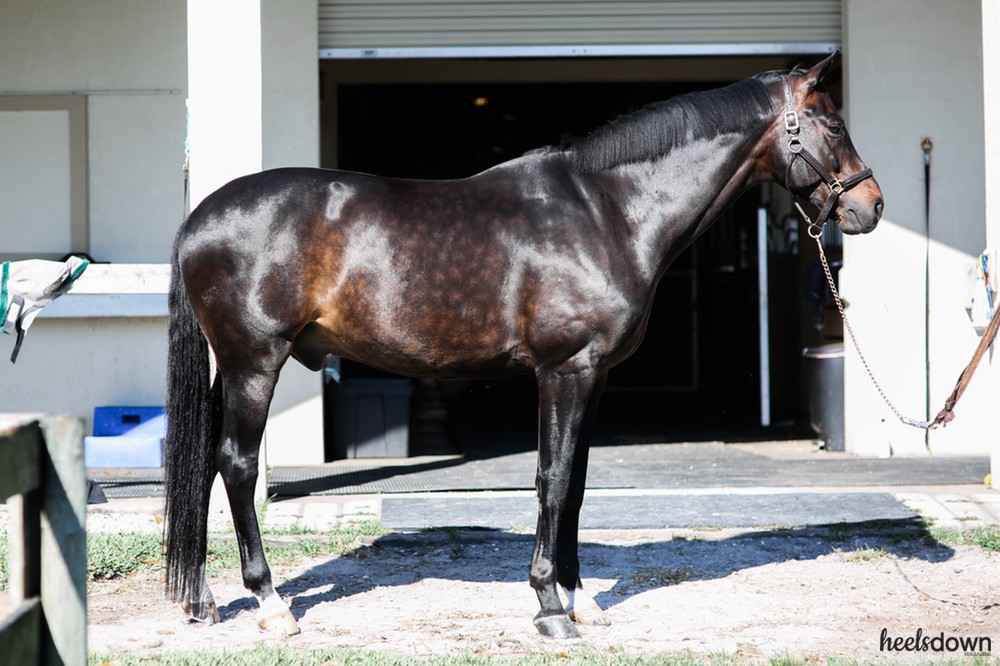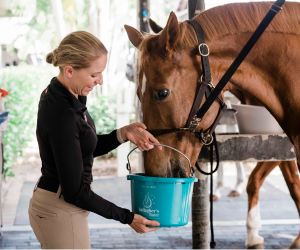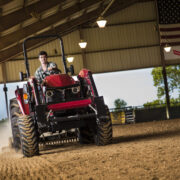Six Easy Steps To Beef Up Your Horse’s Topline

Whether your horse is coming back after an injury or you’re looking for new techniques to build up muscle, establishing a strong topline is vital.
The topline is considered the muscles that line a horse’s back, neck and hindquarters, which work in unison when a horse is moving balanced and correctly. The developed muscles along a horse’s back act as a buffer to the weight of a rider in the saddle. But movement through a horse’s back should be fluid, and have some give.
Often times a horse will develop muscle in the wrong places when forced unnaturally into a frame, which is one way they can develop a weak back. When a horse’s topline is underdeveloped, he is usually unable to move or jump to the best of his ability, and won’t “track up” from behind. A horse with a weak topline will look hollow around his neck and withers, and sometimes sunken near his hips. A horse with a strong topline and ridden correctly will appear relaxed in his movement, will lift in the base of his neck and curve in his loin muscles to give an overall round shape from his poll to his tail.
Here are some tips on how to develop a strong topline in your horse.
1. Assess your situation. Before trying out new riding or lunging exercises, it’s important to first take a look at your horse’s routine and training regiment. Is he fit enough to begin working on a correct contact? Horses who are forced into incorrect frames, often times when they are over-flexed at the poll, will compensate in other ways, like developing muscle in improper areas. Diet can also help or hinder developing muscle in horses. Protein and amino acids are important for muscle retention. It may be worth consulting a nutritionist or vet about altering his diet. Knowing the appropriate skills to ride in a well-balanced manner which does not inhibit the horse’s movement is also important. If a rider is unsure, they should work with a trainer to establish proper and supportive form in the saddle.
Read This Next: Put Your Horse On The Bit Correctly — ‘More of a Feeling Than a Picture’
2. Stretching. There are some specific stretches that riders can do in the barn with their horse to activate a horse’s core. Some are as simple as “carrot stretches”, where riders can encourage their horses to twist and lift their back by using a carrot to guide their head and neck. It’s suggested to ask the horse to stretch to its left and right hips, and to stretch its nose to the ground in between the front feet as a way to warm up the back.
3. Backing up. Another exercise a rider can do from the ground is asking the horse to back up. When backing up, the horse’s hind end will come underneath him and engage his core. While this is commonly used as a groundwork exercise to establish personal space and respect, it is also a great exercise to build muscle in the hind end. It’s recommended to encourage the horse to keep his head low and level if possible while backing up, to properly use his back and hind-end muscles. Start slow with two-to-three steps at a time. Eventually the exercise can build to 20 back steps at a time.
4. Cavaletti on the lunge or under saddle. Pole or cavaletti work on the lunge line or under saddle are great exercises to encourage a horse to lift his back (along with his legs) and drop his head and neck. Start with one or two poles that are appropriately placed a part from one another (consult a trainer if you are unsure on how to measure striding between poles). Walking and trotting is a great place to start until the horse understands the footwork required of the exercise. Then feel free to add more poles and progress to a quiet, balanced canter. For an additional challenge, riders can add raised cavaletti in the place of ground poles.
5. Hill work. Working a horse up and down natural hills is a great way to activate the muscles in his hind end and back in a natural way without trying to maintain a balanced frame. Regular hill work of balanced gaits going both up and down will help build stamina and muscle retention. It’s recommended to do hill work on a loose rein or on a lunge line.
Like This Story? Try Brittany Fraser-Beaulieu’s Exercise For Symmetry And Contact
6. When in doubt, ride less with your hands. Encouraging the horse to ride “long and low”, with its head down and seeking the bit in a loose contact, is a great first step in encouraging him to use his back, shoulders, and hind end freely. Often times incorrect contact comes from the hands, when a rider is too strict in the hold on the horse’s mouth, and therefore the horse leans against the bit and falls on the forehand, or hollows his back. Hacking on a long and loose rein is a great way to encourage open and free gaits, with plenty of room to stretch the back and the hips.


